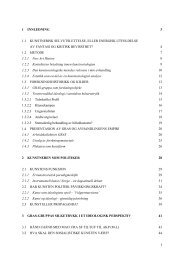2003 Rogaland museum - Gras Katalog - Victor Lind
2003 Rogaland museum - Gras Katalog - Victor Lind
2003 Rogaland museum - Gras Katalog - Victor Lind
You also want an ePaper? Increase the reach of your titles
YUMPU automatically turns print PDFs into web optimized ePapers that Google loves.
ing to real life situations could be successfully transmitted to the creative form and<br />
transformed to carry new import and life. Kleiva achieved this in his Amerikanske<br />
sommarfuglar (1971) where butterfly wings are attached to helicopters, opening for<br />
readings of the completed work that extend beyond a discussion of composition and<br />
form. Another potent example can be seen in Storn’s many eclectic compositions<br />
that include both press clippings and photography. This act emphasised the status of<br />
the subject matter as contemporary; the urgency of the message and the reality of<br />
its subject matter were made clear.<br />
In relation to the physical form of the work, the silkscreen technique not<br />
only ensured the inexpensive reproduction of art – making it available to the common<br />
public – it also made it possible to employ photography and clippings from the<br />
popular press in the creative act, reflecting back onto the subject matter present in<br />
the work. Several of the elements used in the compositions of this period are ones<br />
that the contemporary public would have easily recognised. Specific film footage,<br />
now film stills, appears for example in Krohg’s works Welcome home soldier I and<br />
II (1971). The notion of using the recognisable image was also used by Storn when<br />
he composed Ofring (1971), where a Vietnam scene is placed in a collage that<br />
included an array of popular press clippings – a collage that then became the basis<br />
of the final silkscreen work. Another example is found in <strong>Lind</strong>’s oversized Mere og<br />
mere – flere og flere where the familiar image of death and destruction of war is<br />
multiplied and reproduced, amplifying the morbid reality of the war situation in<br />
sharp contrast to the bright green dollar bills that line the picture’s bottom edge. As<br />
such, Mere og mere – flere og flere can be compared to Warhol’s Five Deaths<br />
Seventeen times in Black and White (1963) and Saturday Disaster (1964), where the<br />
multiplied image of mutilated accident victims is at once numbing as it off-handily<br />
plays with a deep sense of depersonalisation.<br />
A significant difference between Pop art, and especially New York Pop art,<br />
and GRAS was that the latter didn’t play with the idea of capitalistic goods and<br />
value on the same level that Pop art freely could. Pop thrived on the capitalistic culture<br />
from which it sprung; its criticism of that culture, albeit serious at times and frivolous<br />
at others, could more easily be tongue-in-cheek than that political criticism<br />
fronted primarily by <strong>Lind</strong>. Krohg’s Hot Summer – Newark 1967 (1971) reveals<br />
much of the same intensity of criticism as seen in <strong>Lind</strong>’s work, but here Krohg presents<br />
an unnerving sense of dripping sarcasm. Echoing Wesselmann’s Great<br />
American Nudes, Krohg presents a split image where the upper section is filled by<br />
17



